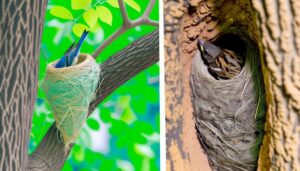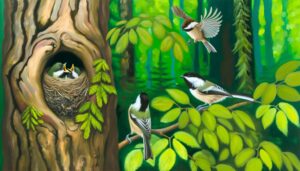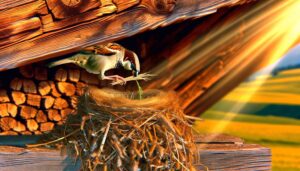7 Tips to Keep English Sparrows Out of Chickadee Nest Boxes
To keep English sparrows out of chickadee nest boxes, start by installing nest boxes with entrance holes of 1 1/8 inches and interior dimensions of 4×4 inches. Place them at a height of 5 to 15 feet in dense foliage or wooded areas.
Use metal entrance plates and extended tunnel entrances to deter sparrows. Regularly inspect and clean the boxes, removing any sparrow nests.
Implement sparrow traps nearby but not too close to the boxes, and be consistent with trapping. These steps will greatly enhance the safety of chickadees in your nest boxes and there's even more you can do to protect them.
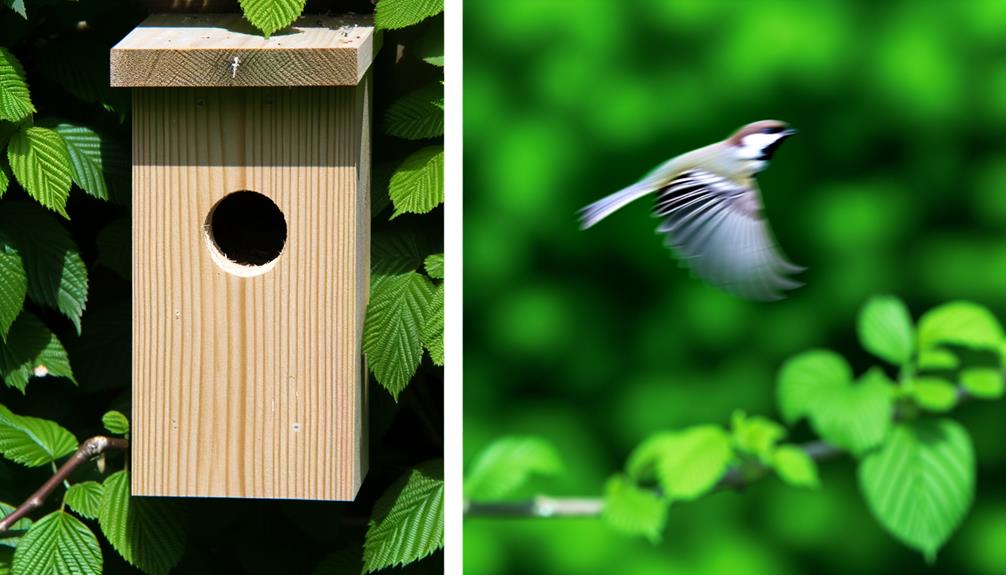
Key Takeaways
- Use entrance holes with a diameter of 1 1/8 inches to deter sparrows.
- Install nest boxes in areas surrounded by dense foliage or wooded regions.
- Incorporate metal entrance plates and extended tunnel entrances to reduce sparrow entry.
- Regularly inspect and clean nest boxes, removing any sparrow nests immediately.
- Employ repeating or funnel traps near nest boxes to control sparrow populations.
Install Proper Nest Boxes
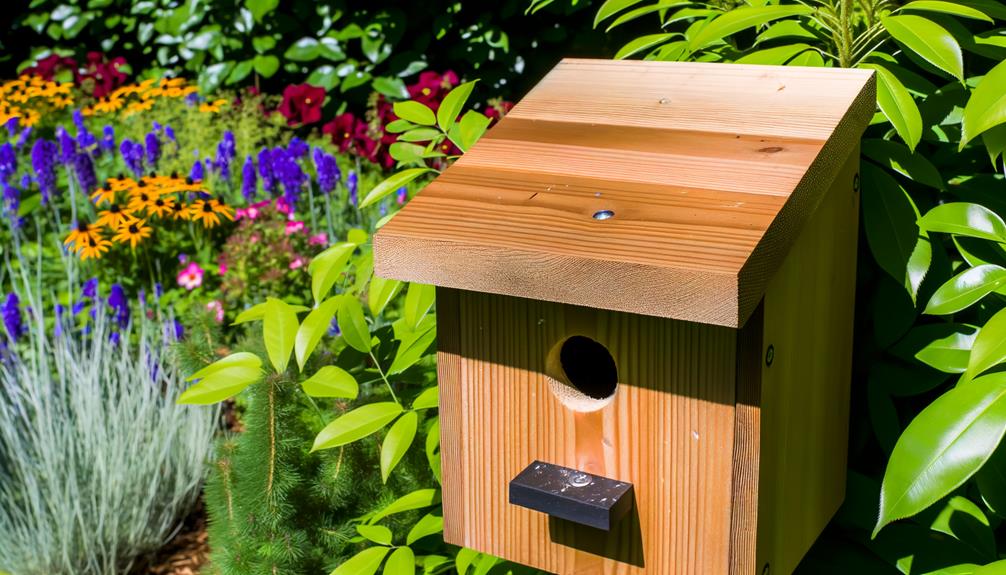
To effectively keep English sparrows out of chickadee nest boxes, you should install nest boxes specifically designed with the appropriate entrance hole size and dimensions tailored for chickadees. Opt for an entrance diameter of 1 1/8 inches, which is ideal for chickadees but too small for larger, invasive English sparrows.
Make sure the box's interior dimensions are compact, around 4×4 inches, to discourage sparrows from nesting. Use high-quality, untreated wood to promote durability and avoid potential toxins. Proper ventilation and drainage are essential; drill small holes at the top and bottom to maintain a healthy environment.
Choose the Right Location
When choosing the right location for chickadee nest boxes, you should place them at a best height of 5 to 15 feet to discourage English sparrows.
Additionally, avoid open areas; instead, select spots surrounded by dense foliage or wooded regions.
This strategy minimizes visibility to sparrows and offers chickadees a safer nesting environment.
Optimal Height Placement
Placing chickadee nest boxes at a height of 5 to 15 feet above ground level greatly reduces the likelihood of attracting English sparrows. This specific height range aligns closely with chickadees' natural nesting preferences.
You'll want to make sure the box is securely fastened to prevent wobbling, which can deter chickadees. Use a solid mounting pole or tree trunk to achieve this stability.
Avoid placing the box too low, where it becomes accessible to predators, or too high, where it may be overlooked by chickadees and attract sparrows.
Regularly inspect and maintain the nest box to keep it in peak condition. By focusing on these precise height parameters, you'll create a welcoming environment for chickadees while discouraging English sparrows.
Avoid Open Areas
Selecting a chickadee nest box location away from open areas greatly reduces the chances of English sparrows taking over the space. You should place the nest box in wooded or densely vegetated areas where chickadees prefer to nest. Sparrows tend to thrive in open, urban spaces, so choosing a more secluded spot will deter them.
Make sure the box is surrounded by trees or shrubs, providing natural cover and reducing visibility. Studies show that chickadees are more likely to inhabit boxes that mimic their natural environment, making it essential to avoid open fields or exposed locations.
Use Sparrow-Resistant Entrances
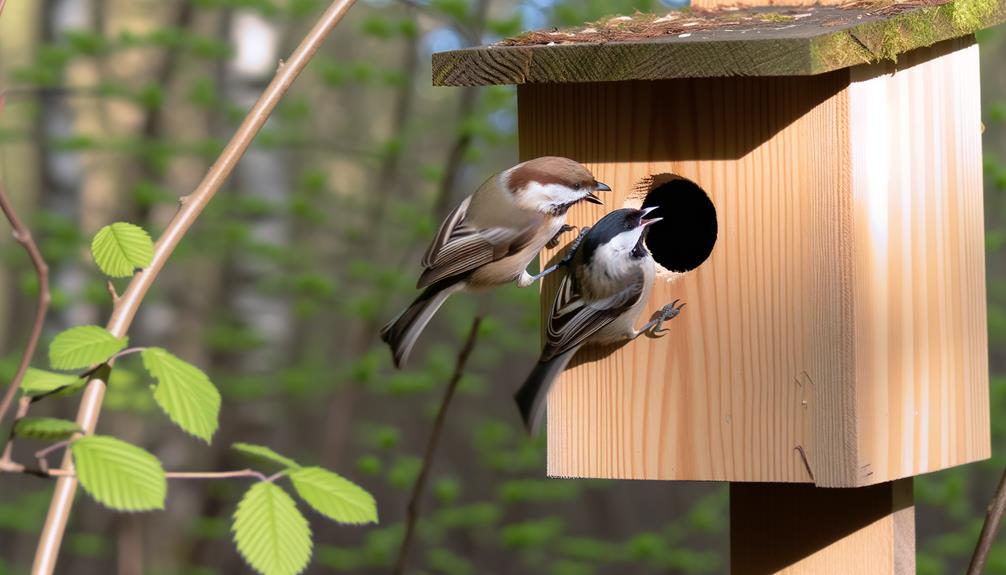
To maximize the effectiveness of your chickadee nest boxes, you should incorporate sparrow-resistant entrances, which are specifically designed to prevent larger, more aggressive English sparrows from entering.
Utilize entrance holes with a diameter of approximately 1 1/8 inches, as chickadees can easily pass through, but sparrows cannot. Consider using metal entrance plates to maintain the integrity of the hole size and prevent sparrows from enlarging the opening.
Additionally, placing an extended tunnel entrance can further discourage sparrows due to their preference for direct access. Ensuring your nest boxes have these modifications will significantly reduce sparrow intrusion, providing a safer environment for chickadees.
Monitor and Clean Regularly
Regularly monitoring and cleaning your chickadee nest boxes is vital for maintaining a healthy and secure nesting environment. Inspect the boxes weekly to identify any early signs of English sparrow intrusion. Check for sparrow nests, which are typically more cluttered and messier than chickadee nests. Remove any sparrow nests immediately to prevent them from laying eggs.
Cleaning the boxes between nesting seasons is crucial. Use a mild bleach solution (one part bleach to nine parts water) to disinfect the interior, ensuring all debris and old nesting material are removed. Rinse thoroughly and let dry before reinstallation.
Regular maintenance not only deters sparrows but also promotes the well-being of chickadees, helping you better serve your local avian community.
Employ Sparrow Traps
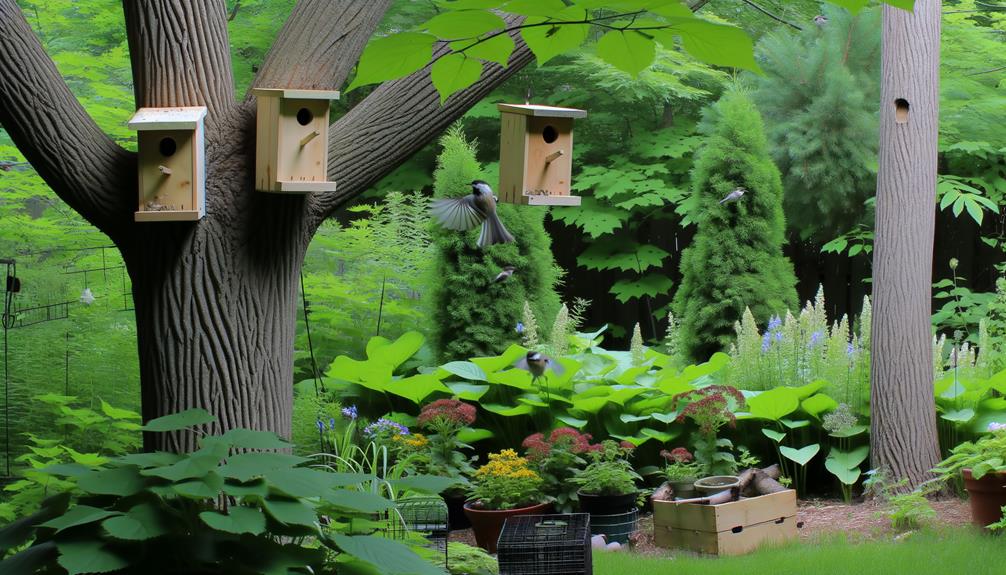
Implementing sparrow traps is an effective method to control the English sparrow population and protect chickadee nest boxes. Traps allow you to humanely capture sparrows, preventing them from taking over chickadee habitats. Use repeating or funnel traps, ensuring they're placed near nest boxes but not too close to deter chickadees. Regularly check and empty traps to maintain efficiency.
| Trap Type | Description |
|---|---|
| Repeating Trap | Catches multiple birds |
| Funnel Trap | Uses a one-way entrance |
| Trigger Trap | Activates with bird's weight |
Scientific studies confirm that sparrow traps notably reduce invasive populations. By actively managing sparrows, you'll provide a safer environment for chickadees to thrive. Remember, consistency and vigilance are key in maintaining an effective trapping program.
Provide Alternative Nesting Sites
By offering alternative nesting sites, you can redirect English sparrows away from chickadee nest boxes, thereby reducing competition and enhancing chickadee survival rates. Strategically placing additional nest boxes specifically designed for sparrows will encourage them to settle there instead. Make sure these alternative sites are attractive and positioned in less desirable chickadee locations to maximize effectiveness.
Employing this method can create a balanced environment where both species coexist without conflict.
Consider these key factors when setting up alternative nesting sites:
- Nest Box Design: Utilize boxes that appeal to sparrows, with appropriate entrance hole sizes.
- Location: Place boxes in open areas, away from dense foliage favored by chickadees.
- Quantity: Provide multiple boxes to accommodate sparrow populations.
- Maintenance: Regularly monitor and clean boxes to ensure they remain attractive.
Discourage Sparrow Feeding
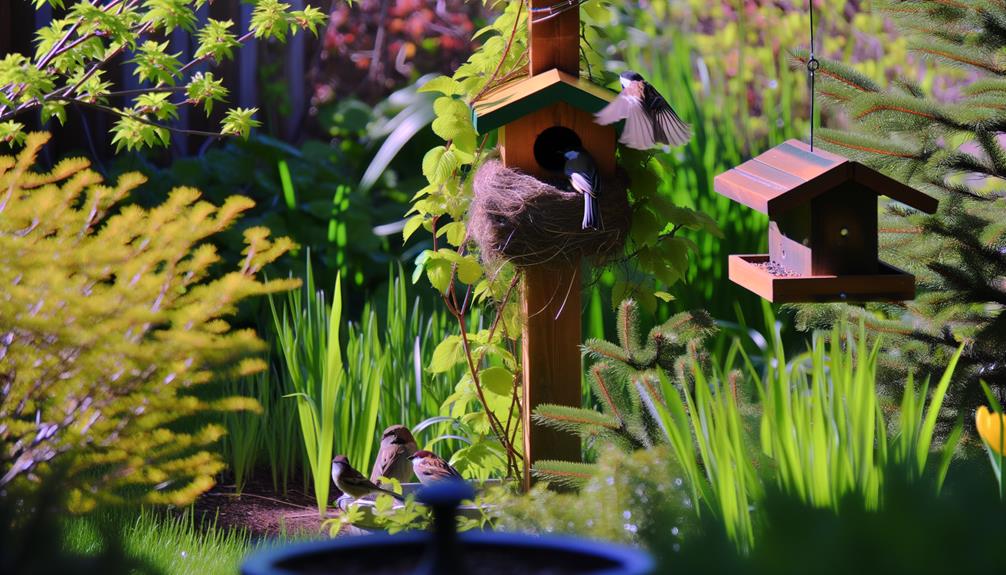
Reducing the food sources that attract English sparrows can significantly decrease their presence around chickadee nest boxes. Start by offering food that chickadees love but sparrows find less appealing. Black oil sunflower seeds and suet are excellent choices. Opt for feeders specifically designed for chickadees, like those with small perches or weight-activated mechanisms that exclude heavier sparrows.
Clean up fallen seeds to minimize ground feeding, which attracts sparrows. Also, avoid using mixed birdseed, as it often contains millet and cracked corn, which sparrows favor. By strategically selecting food types and feeder designs, you can create an environment that supports chickadees and discourages sparrows, thereby protecting the nest boxes and promoting a harmonious habitat.
Maintain Habitat Diversity
A diverse habitat, rich with native plants and varied vegetation layers, can naturally deter English sparrows while providing ideal conditions for chickadees. By fostering such an environment, you create a balanced ecosystem that supports chickadees' needs and makes it less appealing for invasive species like sparrows.
Here's how you can enhance habitat diversity:
- Plant native shrubs and trees: These provide food and shelter for chickadees.
- Create layers of vegetation: Include ground cover, mid-level shrubs, and canopy trees.
- Incorporate flowering plants: They attract beneficial insects, which are a food source for chickadees.
- Ensure seasonal variety: Choose plants that offer resources throughout the year.
Conclusion
By following these steps, you're on the right track to keeping English sparrows out of chickadee nest boxes. Remember, an ounce of prevention is worth a pound of cure.
Proper nest boxes, careful location choices, and sparrow-resistant entrances are essential.
Regular monitoring and cleaning, along with sparrow traps and alternative nesting sites, will further help.
Discourage sparrow feeding and maintain habitat diversity for the best results. Your chickadees will thank you for it!

